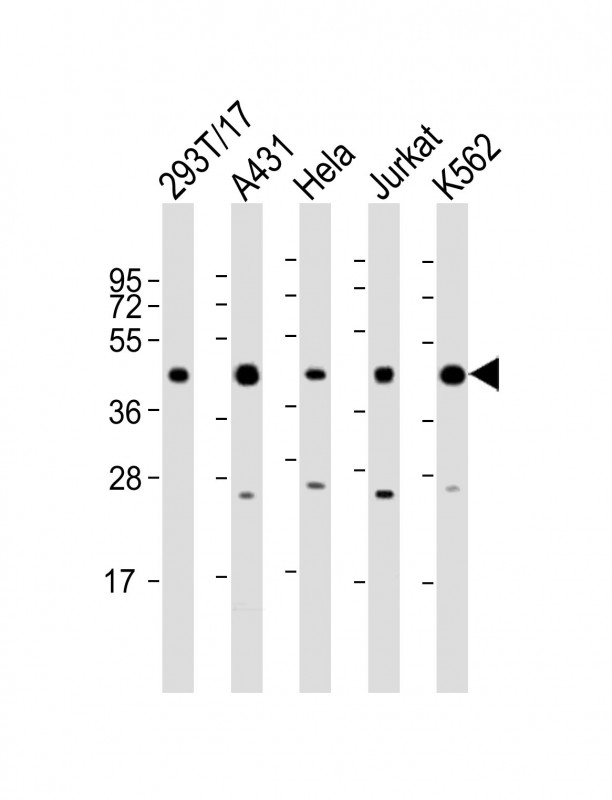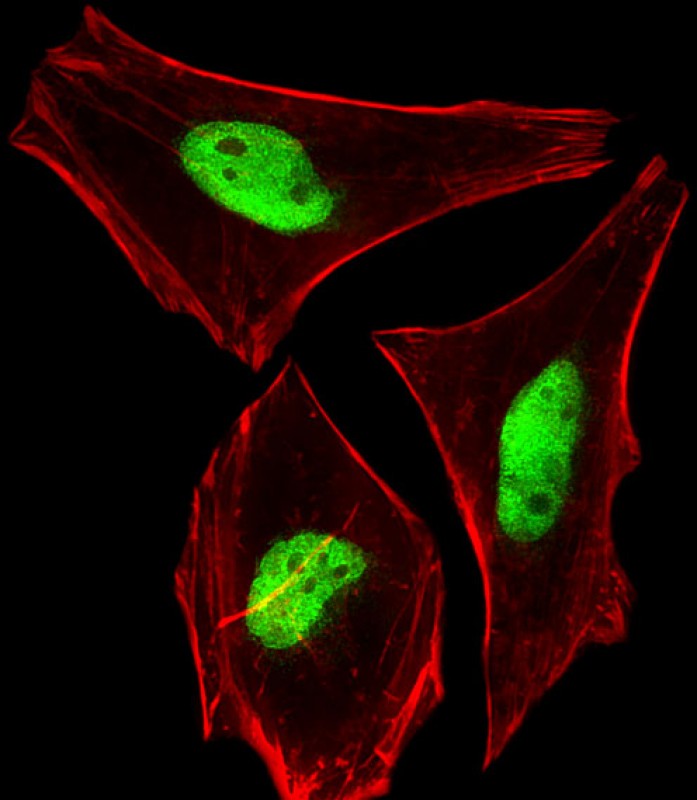

| WB | 1/2000 | Human,Mouse,Rat |
| IF | 咨询技术 | Human,Mouse,Rat |
| IHC | 咨询技术 | Human,Mouse,Rat |
| ICC | 1/25 | Human,Mouse,Rat |
| FCM | 咨询技术 | Human,Mouse,Rat |
| Elisa | 咨询技术 | Human,Mouse,Rat |
| Aliases | PHD finger protein 6, PHD-like zinc finger protein, PHF6, CENP-31, KIAA1823 |
| Entrez GeneID | 84295 |
| WB Predicted band size | 41.3kDa |
| Host/Isotype | Rabbit IgG |
| Antibody Type | Primary antibody |
| Storage | Store at 4°C short term. Aliquot and store at -20°C long term. Avoid freeze/thaw cycles. |
| Species Reactivity | Human, Mouse |
| Immunogen | This PHF6 antibody is generated from a rabbit immunized with a KLH conjugated synthetic peptide between 315-349 amino acids from human PHF6. |
+ +
以下是3-4篇关于PHF6抗体的参考文献(信息基于公开研究整理,具体文献需核实):
1. **文献名称**:*PHF6 mutations in hematopoietic malignancies*
**作者**:Voss AK, et al.
**摘要**:研究通过Western blot和免疫组化验证PHF6抗体在白血病细胞系中的特异性,发现PHF6缺失与急性髓系白血病进展相关,揭示了其表观遗传调控功能。
2. **文献名称**:*The role of PHF6 in neuronal development and intellectual disability*
**作者**:Todd MA, Picketts DJ.
**摘要**:利用PHF6抗体进行免疫荧光和ChIP-seq,发现PHF6在神经元分化中调控染色质重塑复合物,突变导致智力障碍相关基因表达异常。
3. **文献名称**:*PHF6 regulates the differentiation and survival of T cells*
**作者**:Chong SJ, et al.
**摘要**:通过流式细胞术和免疫沉淀实验(使用PHF6抗体),证明PHF6通过调控NOTCH1信号通路影响T细胞激活,缺失导致免疫缺陷表型。
4. **文献名称**:*PHF6 interacts with the NuRD complex to suppress tumor metastasis*
**作者**:Lower KM, et al.
**摘要**:结合Co-IP和PHF6抗体验证,发现PHF6与NuRD复合物互作抑制乳腺癌转移,突变体失去结合能力并促进侵袭。
(注:以上为示例,实际文献需通过PubMed或学术数据库检索确认。)
The PHF6 antibody is a crucial tool in studying the role of PHF6 (PHD Finger Protein 6), a gene located on the X chromosome (Xq26.3) encoding a chromatin-associated protein. PHF6 contains two plant homeodomain (PHD) zinc-finger motifs, suggesting involvement in chromatin remodeling and transcriptional regulation. It is ubiquitously expressed, with high levels in the brain, and plays roles in neurodevelopment, cell cycle control, and differentiation. Mutations in PHF6 are linked to Börjeson-Forssman-Lehmann syndrome (BFLS), an X-linked intellectual disability disorder, and are recurrently observed in hematological malignancies like T-cell acute lymphoblastic leukemia (T-ALL) and acute myeloid leukemia (AML). PHF6 acts as a tumor suppressor, interacting with components of the NuRD complex and regulating genes involved in apoptosis and proliferation.
PHF6 antibodies are widely used in research to detect protein expression, localization, and interactions via techniques such as Western blotting, immunohistochemistry (IHC), and immunofluorescence (IF). They aid in exploring PHF6's role in epigenetic regulation, its loss-of-function mechanisms in diseases, and potential therapeutic targets. Validation of these antibodies is critical, as PHF6 exhibits tissue-specific isoforms and post-translational modifications. Commercial PHF6 antibodies vary in specificity, often targeting epitopes within its N-terminal or C-terminal regions. Ongoing studies utilizing these antibodies continue to uncover PHF6's complex roles in development and disease, highlighting its importance in both basic and clinical research contexts.
×